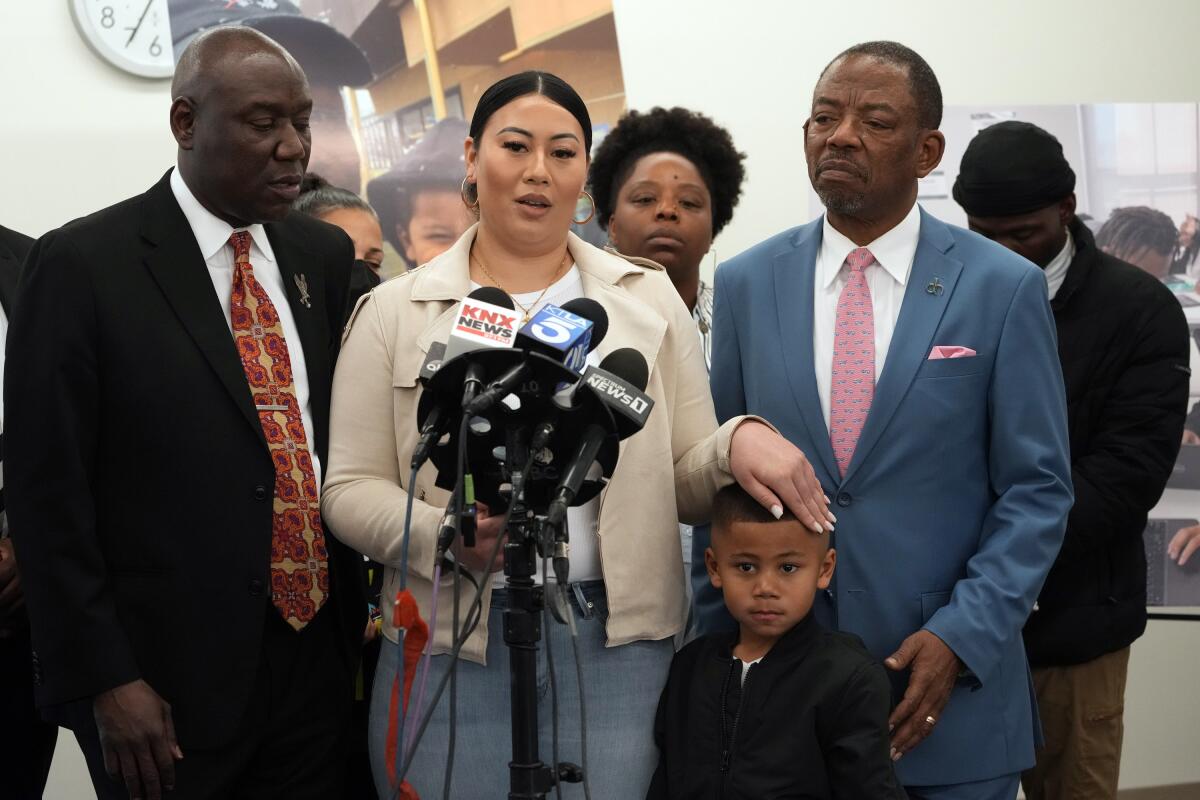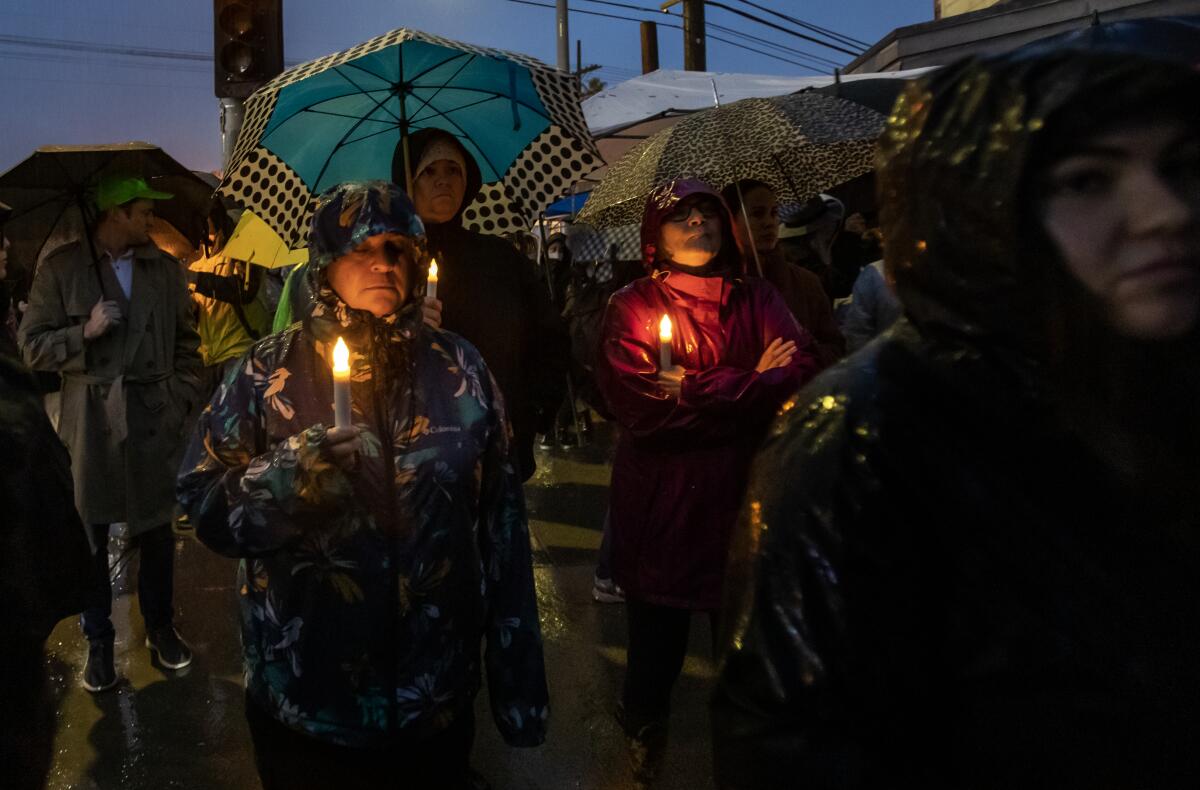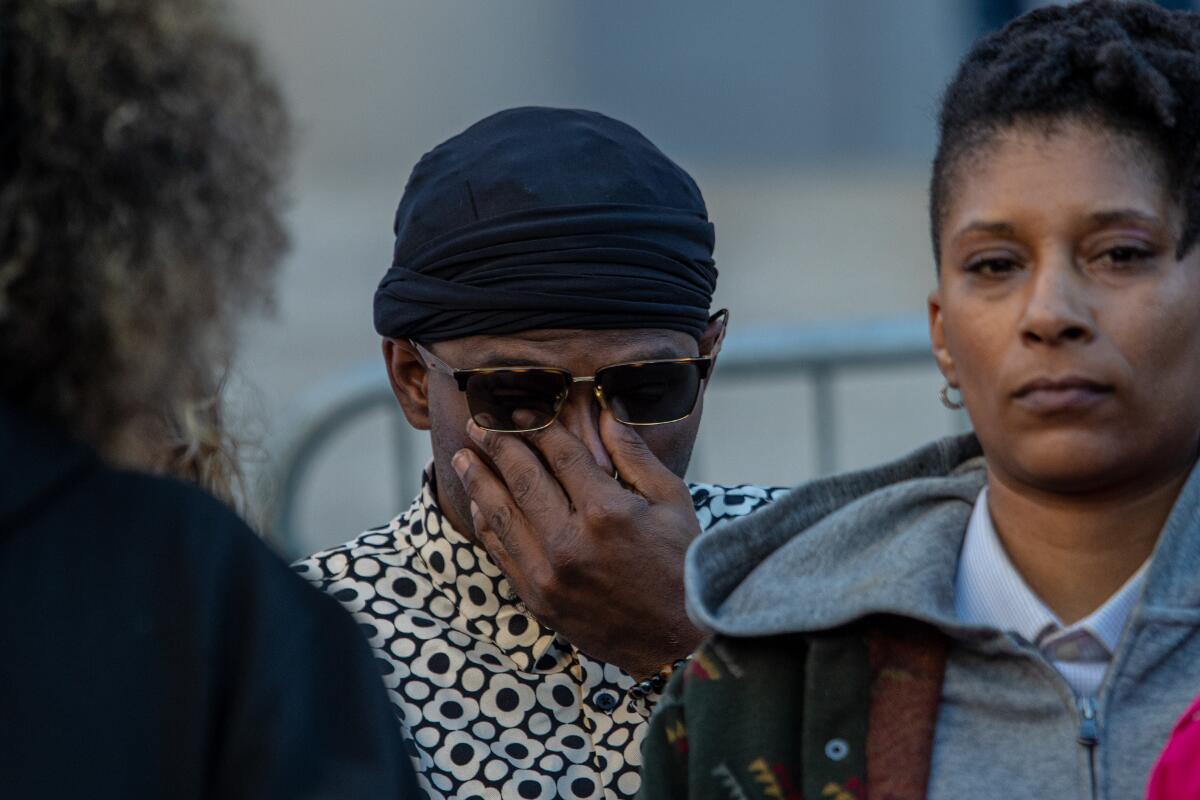Keenan Anderson’s family files $50-million legal claim after tasing by LAPD

- Share via
Civil rights lawyers acting on behalf of Keenan Anderson’s young son have filed a $50-million wrongful-death claim against the city of Los Angeles, alleging the 31-year-old teacher died as a result of “serious injuries” he suffered when an LAPD officer repeatedly tased him after a traffic collision.
The legal action, which is a precursor to a lawsuit unless the city opts to admit liability, comes after the Los Angeles Police Department released video footage of the Jan. 3 incident from cameras worn by officers who wrestled with Anderson while trying to detain him.
“We saw a man who was afraid,” said attorney Carl Douglas at a news conference Friday. “We saw a man who was unarmed and compliant.”
The incident occurred after officers responded to a multicar accident at a busy intersection in Venice. Other drivers blamed the crash on Anderson, who was agitated and talking incoherently. He initially followed an officer’s orders to sit on the sidewalk but then ran into the intersection.
A group of officers struggled to control Anderson, who resisted their efforts to put him on his stomach and handcuff him. As officers used their body weight and arm holds, another officer discharged a Taser stun gun on him at least six times in 42 seconds, according to details released by the LAPD.
Anderson died several hours later at a hospital. The cause of his death and whether the multiple, powerful shocks from the Taser played a part in it have not been determined. Police said preliminary tests found cocaine and cannabis in Anderson’s system but did not provide any information about when he may have ingested the drugs.
The actions of the officers have sparked protests, an internal investigation and calls for changes to police policies related to traffic collisions and the use of stun guns. Anderson’s death has attracted heightened attention because he was a cousin of Patrisse Cullors, one of the founders of the Black Lives Matters organization who has taken to social media to blame the officers for killing him.
Surrounded by Cullors and other family members, Benjamin Crump, an attorney who has represented many of the nation’s high-profile victims of police brutality, and Douglas, a member of O.J. Simpson’s defense team at his murder trial, announced Friday that they had filed the claim on behalf of Anderson’s 5-year-old son.
“This is the story of a 5-year-old young man who will never be able to enjoy another day in the presence of his father,” Douglas said, standing next to the boy. He said that Anderson had been complying with a motorcycle officer order to sit on the sidewalk until several officers ran at him. Like other Black men who distrust the police, Douglas said, Anderson feared for his safety and bolted into the street.
The video released by the LAPD does not show the other officers approaching Anderson.
Saying the force that the officers used amounted to an “unlawful assault and battery,” the attorneys wrote in the claim that said Anderson suffered “serious injury and damages to his mind and body, and four and one-half hours later dies as a result of the injuries and damages he sustained at the hands of the LAPD police officers.”
“Mr. Anderson did nothing to justify this use of serious and unreasonable force against him,” the claim said. “He was unarmed when officers attempted to detain him, and had not posed any reasonable threat of serious bodily injury to each of the unknown involved police officers, or any other person, so as to justify this use of unreasonable deadly force against him. He was merely suspected of potentially being involved in a minor traffic collision.”
“Six times in 42 seconds. All that electricity thrust upon his body,” Crump said, referring to the Taser strikes. He noted that as the officers tried to take Anderson into custody, he yelled out the name of George Floyd, who died when a Minneapolis police officer kneeled on his neck for several minutes during an arrest.
A spokesperson for the LAPD declined to respond to the claim, saying the department cannot comment on pending litigation. LAPD Chief Michel Moore and Mayor Karen Bass have both pledged an extensive investigation into Anderson’s death.
His death, along with two fatal shootings by LAPD officers that occurred around the same time, come at particularly delicate moments for the mayor, who campaigned in part on reducing police violence, and Moore, who is seeking a second term as chief.
In his comments on the incident, Moore has pushed back against the notion that the officers overreacted by trying to take Anderson into custody, saying he was a felony hit-and-run suspect in some sort of altered mental state who had tried to get into another person’s car and then resisted officers’ efforts to detain him.
The department has not identified any of the officers involved in the arrest.
On Friday, the LAPD said all but one of the six officers involved in arresting Anderson has returned to work. “The six officers involved in the Anderson case were relieved of field duties at the time of the incident, and five have since returned,” the department said in a statement. “The focus of this critical incident has been the application taser, and is being looked at closely. The officers returning to the field, or remaining on leave, should not be interpreted as any final judgment of whether their actions were in or out of policy.”
Several policing experts who reviewed the videos for The Times said the amount of force used by the officers seemed excessive given Anderson’s actions and that their tactics appeared haphazard.

In the initial encounter between Anderson and a traffic officer who arrived on a motorcycle, the video shows Anderson wandering in the intersection and the officer calmly ordering him to get on the sidewalk.
Anderson complied, sitting on the sidewalk. He appeared panicked and incoherent, at one point saying, “I want people to see me,” and “you’re putting a thing on me.”
When Anderson got up and ran, the officer quickly caught up to him, angrily yelling at him to lie on his stomach in the street. As a swarm of officers moved in, Anderson cried out to onlookers, “Please help me,” and said the officers were “trying to kill me.”
Officers then attempted to pin him down. One can be seen in the video placing his elbow on Anderson’s neck while he lies on his back. The officer standing above him shouted, “Turn over, or I’m going to tase you.”
The officer with the Taser tried twice to fire the small darts from the weapon that are meant to embed in a person’s skin and discharge muscle-constricting electrical pulses. When that appeared to have no effect, the officer pressed the Taser directly against Anderson’s torso and delivered at least four bursts of electricity over about 30 seconds.
Gabrielle Hansell, the mother of Anderson’s son, speaking at the news conference, said “having to hear Keenan cry out for help the way he did and to watch him to be hurt by other people ... I will never get over.” She said her son will one day see the video and she doesn’t know how she will answer his questions.
According to the legal claim, the lawyers for the family said it was not just the Taser that harmed Anderson and claimed he was not resisting arrest. “Other officers press Mr. Anderson body‘s against the hardened street surface as they struggle to pull his arms behind his back. Mr. Anderson’s efforts to struggle for air and squirming in response to the unlawful application of taser force, are misinterpreted as evidence of his active resistance,” the claim alleges.
The attorneys allege that the officers were inadequately trained and negligently handled the encounter with Anderson.

Moore has said LAPD policy does not place a limit on the number of times a Taser can be used on a person, requiring only that the actions must be reasonable given the totality of the circumstances. Under the current rules, which were adopted in 2021, an officer may use a Taser if a person is deemed to pose “an immediate threat” to officers or others.
In the wake of Anderson’s death, some community activists have called for new limits on Taser use by officers as well as a ban on armed officers responding to traffic-related calls.
Incidents in which officers used a Taser have declined from 577 in 2016 to 200 in 2022, according to LAPD data. The overall number of times a Taser was activated in those incidents also declined. Taser activations fell from 1,363 in 2016 to 432 in 2022.
More to Read
Sign up for Essential California
The most important California stories and recommendations in your inbox every morning.
You may occasionally receive promotional content from the Los Angeles Times.














